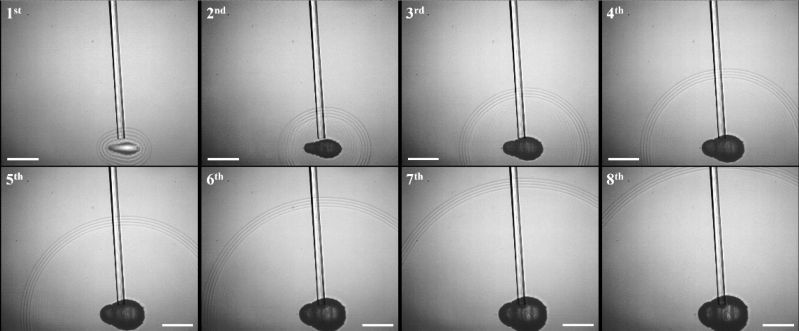A Specialised Imaging KIRANA ultra-high-speed video camera has proved invaluable to a team at the University of Ljubljana working to measure pressures across shockwaves in fluids with a possible real world outcome to improve procedures using lasers such as eye surgery.
A Specialised Imaging KIRANA ultra-high-speed video camera has proved invaluable to a team at the University of Ljubljana working to measure pressures across shockwaves in fluids with a possible real world outcome to improve procedures using lasers such as eye surgery.
In theory the shock waves from a laser generated bubble imploding at the targeted location in a fluid could be harnessed to improve outcomes and reduce the invasive nature inherent with traditional surgical procedures. Despite the length scales being a few hundred microns, the shockwaves involved are relatively strong so the magnitude of such a pressure wave and its impact on the surrounding tissue needs to be better understood.
Pressures in fluids can be measured directly using a fibre-optic probe hydrophone (FOPH) but this can affect the experimental volume. Alternatively, if the velocity of the shockwave can be measured, the pressure across the shock can be calculated for a particular fluid. To measure fluid movement a non-invasive imaging technique called frame straddling PiV (Particle Image Velocimetry) could be used to measure shock wave movement, but the velocity measurement sampling rate is half that of the camera frame rate. Instead, the team used a shadowgraph set up to capture multiple exposures (using multiple illumination laser pulses) within each camera image exposure duration enabling measurement of the velocity at the camera frame rate.
By using two key elements – a highly accurate and adjustable illumination laser capable of generating picosecond accurate pulses at a frequencies up to 200MHz and the KIRANA ultra high-speed camera, the team was able to calculate shock generated overpressures at Megahertz sampling rates which is significantly faster than previously achieved.
Shock wave propagation following a single laser-induced breakdown (LIB) event is shown on these eight consecutive images from the KIRANA camera recording at 5 MHz. The propagating shockwave is illuminated by the laser 4 times in each image. From this known illumination laser pulse spacing the shockwave velocity can be calculated for each image. The 200ns interframe time allows the velocity profile and increase in pressure across the shockwave to be calculated. The fibre-optic probe hydrophone (FOPH) is visible in the images, providing verification of shock pressure and time of flight measurements at its tip position. Scale bars equal to 500μm.
These small but important steps towards real world aims often require specialist experimental techniques using unique equipment such as the 200MHz illumination laser developed by Ljubljana University and the Kirana Ultra high-speed camera from Specialised Imaging.
Read Multi-frame multi-exposure shock wave imaging and pressure measurements:
https://opg.optica.org/oe/fulltext.cfm?uri=oe-30-2...
Read the SI Application note:
https://specialised-imaging.com/application/files/2316/6560/6262/SI_RA_PetkovsekR_2022OE_Multi-frame_shockwave.pdf




























